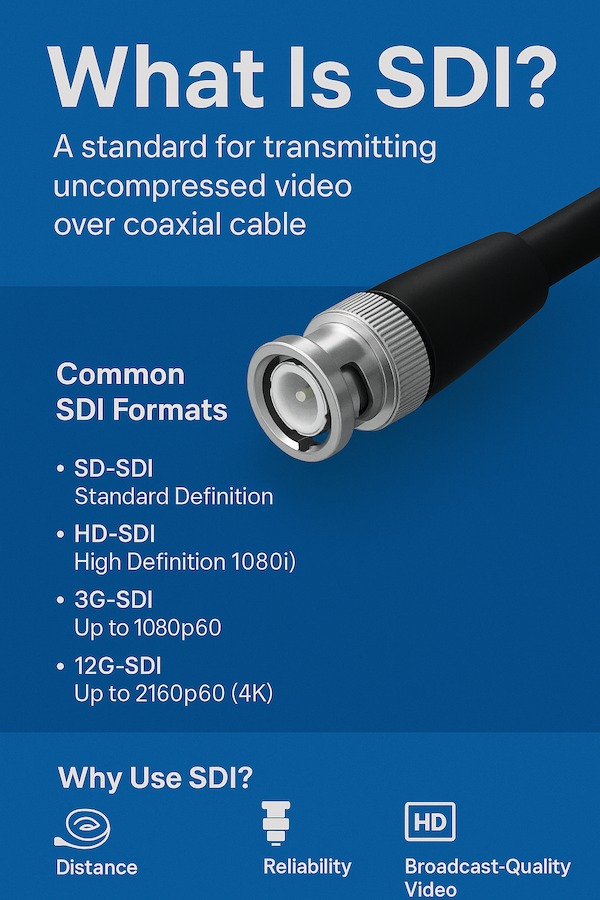If you’ve ever peeked behind the curtain at a live event or on a production truck, you’ve probably seen thick black cables labeled “SDI.” But what is SDI exactly? And why, in a world of HDMI and wireless streaming, are we still using it?
I’ve worked in live AV production for over a decade—everything from luxury weddings and investor meetings to 4,000-person concerts in the Arizona heat—and SDI still remains one of the most reliable, professional-grade tools in our kit.
So let’s break it down.
SDI Stands for Serial Digital Interface
At its core, SDI (Serial Digital Interface) is a professional video standard developed for sending uncompressed, high-quality video over long distances using coaxial cable. It’s most commonly used in broadcast, live events, video walls, camera feeds, and anywhere video needs to be transmitted with low latency and high reliability.
You might not see SDI in action at your event—but if you’re watching a live camera feed on a screen, or if we’re switching multiple camera angles live on an LED wall, chances are SDI is behind it.
How SDI Is Different From HDMI
If you’re more familiar with HDMI (what you plug into your TV at home), here’s the short version:
| Feature | SDI | HDMI |
|---|---|---|
| Cable Type | Coaxial (BNC) | Standard HDMI |
| Distance | Up to 300 ft (or more) without boosters | Typically under 50 ft |
| Locking Connector | ✅ Yes (BNC twist-lock) | ❌ No |
| Signal Type | Uncompressed digital video/audio | Uncompressed, but less robust in live environments |
| Use Case | Pro AV, broadcast, cameras, switchers | Home theater, laptops, some conference gear |
At Centric Events, we almost always prefer SDI for camera feeds, live switching, and video wall connections—especially when we’re working in large spaces or when a rock-solid connection is critical.
The Different Types of SDI
Depending on resolution and frame rate, SDI comes in a few common “flavors”:
- SD-SDI – Standard Definition (not used much anymore)
- HD-SDI – High Definition (up to 720p/1080i)
- 3G-SDI – Full HD 1080p at 60fps (very common)
- 6G-SDI / 12G-SDI – 4K and beyond
Most of our gear at Centric uses 3G-SDI or 6G-SDI, especially for live camera switching and high-res LED displays. These cables look the same externally, but internally they’re engineered to handle more data at higher speeds.
Why AV Professionals Still Use SDI in 2025
Here’s the honest truth: HDMI is easier for consumers. It’s what your laptop uses, what your Xbox uses, what your hotel ballroom is probably set up for. But for live AV production—especially when we’re juggling multiple video feeds, long cable runs, and real-time switching—HDMI just doesn’t cut it.
Here’s why we keep SDI in our toolkit:
- Distance – We’ve run SDI cables hundreds of feet across ballrooms, outdoor venues, and catwalks without signal loss. HDMI simply can’t do that without boosters or converters.
- Reliability – SDI cables lock into place with a twist-lock BNC connector. That means no accidental unplugs mid-event.
- Flexibility – We can route multiple SDI feeds into switchers, recorders, monitors, and LED processors without fuss.
- Broadcast-Quality Video – SDI supports clean, uncompressed video at full resolution and frame rate. No lag. No artifacts.
We use SDI for every high-stakes show—from multi-cam conference coverage to brand activations that rely on sharp, glitch-free visuals.
Real-World Example: Why SDI Saved the Show
A few months ago, we were working a corporate event in Scottsdale. The client brought in their own camera team who only had HDMI outputs. Halfway through setup, they realized the main screen was 150 feet away—and HDMI couldn’t reach without losing signal.
Our crew quickly converted the HDMI output to SDI using a small converter box, and ran SDI to the video switcher at the back of the room. Problem solved. No delays. No pixelation.
That’s just one of dozens of times SDI saved the show.
But Isn’t Everything Going IP?
It’s true—AV over IP (like NDI or Dante AV) is growing fast, and I’m excited about where that’s heading. But IP requires perfect network infrastructure, specific switch configuration, and zero margin for error when latency matters.
For now, SDI remains the gold standard for reliable, professional, real-time video—especially in live events where timing, quality, and trust are everything.

Final Thoughts
If you’re planning a live event, upgrading your venue, or trying to figure out why your video wall keeps flickering—SDI might be the answer. It’s not the flashiest topic, but it’s one of those things that separates pros from hobbyists.
And at Centric Events, we don’t just show up with speakers and screens—we design systems that work under pressure. SDI is a big part of that reliability.
If you’ve got questions about your venue’s setup, need help understanding your camera system, or just want a sanity check on what cables to use—reach out. I’m happy to help, or even walk your team through best practices.
Daniel Pitner is the Director of Sales & Marketing at Centric Events, which he originally co-founded 12 years ago as Arizona Production Rentals with Dustin Dluhy. Blending a strong background in sales with years of digital marketing experience, Daniel helps clients deliver impactful, seamless conferences and live events through thoughtful, creative A/V production.
